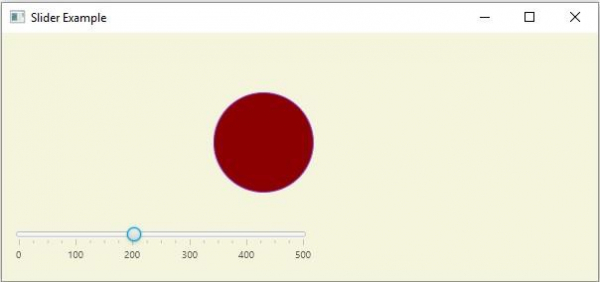
 Data Structure
Data Structure Networking
Networking RDBMS
RDBMS Operating System
Operating System Java
Java MS Excel
MS Excel iOS
iOS HTML
HTML CSS
CSS Android
Android Python
Python C Programming
C Programming C++
C++ C#
C# MongoDB
MongoDB MySQL
MySQL Javascript
Javascript PHP
PHP
- Selected Reading
- UPSC IAS Exams Notes
- Developer's Best Practices
- Questions and Answers
- Effective Resume Writing
- HR Interview Questions
- Computer Glossary
- Who is Who
How to set action to a slider using JavaFX?
JavaFX provides a class known as Slider, this represents a slider component which displays continuous range of values. This contains a track on which the number values are displayed. Along the track there is a thumb pointing to the numbers. You can provide the maximum, minimum and initial values of the slider.
Setting action to the slider
The property of the slider class named value, represents the current value of the slider, the valueProperty() returns a property object representing the current value of the slider. You can set action when the value is changed, by adding listener to this property, using the addListener() method.
Example
In the following JavaFX example, we have created a slider and a circle.
We have instantiated the Translate (transformation) class and linked the slider new value to the translate value along the x axis and added the translate transform to the circle.
import javafx.application.Application;
import javafx.beans.value.ChangeListener;
import javafx.beans.value.ObservableValue;
import javafx.geometry.Insets;
import javafx.scene.Scene;
import javafx.scene.control.Slider;
import javafx.scene.layout.VBox;
import javafx.scene.paint.Color;
import javafx.scene.shape.Circle;
import javafx.scene.transform.Translate;
import javafx.stage.Stage;
public class SliderAction extends Application {
@Override
public void start(Stage stage) {
//Drawing a Rectangle
Circle circle = new Circle(50);
circle.setFill(Color.DARKRED);
circle.setStroke(Color.BLUEVIOLET);
//Setting the slider
Slider slider = new Slider(0, 500, 0);
slider.setShowTickLabels(true);
slider.setShowTickMarks(true);
slider.setMajorTickUnit(100);
slider.setBlockIncrement(50);
//Setting the width of the slider
slider.setMaxWidth(300);
//Creating the translation transformation
Translate translate = new Translate();
//Linking the transformation to the slider
slider.valueProperty().addListener(new ChangeListener<Number>() {
public void changed(ObservableValue <?extends Number>observable, Number oldValue, Number newValue){
translate.setX((double) newValue);
translate.setY(50);
translate.setZ(100);
}
});
//Adding the transformation to the circle
circle.getTransforms().add(translate);
//VBox to arrange circle and the slider
VBox vbox = new VBox(85);
vbox.setPadding(new Insets(10));
vbox.getChildren().addAll(circle, slider);
vbox.setStyle("-fx-background-color: BEIGE");
//Preparing the scene
Scene scene = new Scene(vbox, 600, 250);
stage.setTitle("Slider Example");
stage.setScene(scene);
stage.show();
}
public static void main(String args[]){
launch(args);
}
}
Output
On executing the above program, it will generate a JavaFX window with a slider and a circle on it. If you move the slider the circle will slide along the x-axis.


